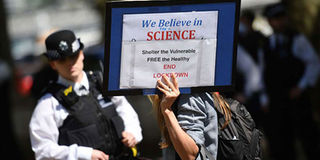'The Plague': Life and death under lockdowns

One of a small group of anti-lockdown protesters speaks to a police officer as they gather outside New Scotland Yard in Victoria, London, on May 2, 2020, during the nationwide lockdown to curb coronavirus pandemic. PHOTO | JUSTIN TALLIS | AFP
What you need to know:
- What is celebrated in The Plague as is celebrated every day in the battle against coronavirus is the commitment and fortitude of individuals.
I have just travelled through another book.
What else is there to do when you need a break from checking the daily record of coronavirus cases and deaths — or watching the circus of Donald Trump’s press briefings?
It hasn’t been a relaxing travel — The Plague by Albert Camus is not an easy ride. The spine of my copy has yellowed with age.
I read it when I was a student — and that is longer ago than I wish to tell you. I took it up again because I thought it has something to say about our present coronavirus predicament. It certainly does.
The novel’s setting is Oran, a port city on the north-west coast of Algeria. Camus published it in 1947 — two years after the end of Second World War.
Some see the book as an allegory of Nazi occupation. I don’t know about that. What I do know is that it is a powerful and moving description of what can happen to individuals and communities when they are locked down for a long time because of an epidemic.
The dramatic heart of Camus’ novel is the relationship between a few characters caught up in the struggle to counteract the disease.
One is a doctor, another a priest. One is what religious people would call a non-believer and the other, of course, is a believer.
SOCIAL LIFE
I am struck by the contrast with the stories I often used to turn to — the stories of the rivalry between Don Camillo, the Italian Catholic priest, and Peppone, the Communist mayor.
They are amusing tales, and ones you can enjoy reading in bed before you fall asleep.
The Plague is not a book to read in bed. The ideological rivalry of Doctor Rieux and Father Paneloux is too deep and disturbing. They both witness the death throes of a young boy, the son of a friend. It is something that tests the different faiths of both.
The fictional lockdown of Oran is different in a number of ways from the real lockdowns that are happening around the world now.
In 1947, there was no television, no mobile phones, no internet and no social media. When the telephone wires became clogged, there was only the austerity of telegrams to communicate with relatives, lovers and friends outside the walls of the city.
Our isolation is much less of a burden for many of us. We have more ways to be in touch, though not physically. We have more ways to keep ourselves amused or even keep ourselves at work.
However, and this is what stirred me — there is much in the book that touches on what we are going through now.
For the people of Oran, it took some time before the problem, which seemed like one that would end soon, turned into something ‘whose scope could not be measured, and whose origins could not be detected’.
IGNORANCE
The point is made that there have been as many plagues as wars in history, yet they always take people equally by surprise.
Some preachers see such pestilences as God’s judgement for the prevalence of sinning — yet how do you justify the deaths of innocent children?
Many people in Oran believed at first that alcohol was a safeguard against infections. No doubt Mike Sonko (Nairobi governor) would have been one of those believers.
This is another example of what Camus called ‘the most incorrigible vice’ — the ignorance. Like the ignorance of Trump, who can suggest that an injection of disinfectant into the lungs might cure coronavirus.
On the other hand, what is celebrated in The Plague as is celebrated every day in the battle against coronavirus is the commitment and fortitude of individuals who might not be saints, but who ‘strive their utmost to be healers’.
John Fox is chairman of iDC





